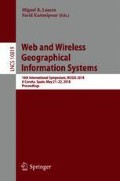Abstract
The boreal forest ecosystem of Alberta is increasingly affected by the human development related to natural-resource extraction, pipelines, roads and seismic lines. To evaluate the efficiency of restoration treatments, this project aims at the monitoring of physical conditions and human/wildlife presence on a recovered seismic lines ecosystem. For monitoring human and animal uses of industrial linear features, an Internet of Things (IoT) prototype system is developed with open source hardware, and open interoperable IoT standard. We try to build an accurate and cost-effective tool to detect the impact of human footprint and monitor the habit of the wild animal. So we implemented four types of trail counter which is a low-cost, open-source measurement device that counts pedestrian, bikes, all-terrain vehicles (ATVs), cars, and animals on trails, paths, and sidewalks.
Access this chapter
Tax calculation will be finalised at checkout
Purchases are for personal use only
References
Juang, P., Oki, H., Wang, Y., et al.: Energy-efficient computing for wildlife tracking: design tradeoffs and early experiences with ZebraNet. In: Proceedings of 10th International Conference Architecture Support for Programming Languages and Operating Systems (ASPLOS 2002), pp. 96–107 (2002). https://doi.org/10.1145/605397.605408
Zviedris, R., Elsts, A., Strazdins, G.: LynxNet : Wild Animal Monitoring Using Sensor Networks, pp. 2–5 (2009)
Matthews, A., Ruykys, L., Ellis, B., et al.: The success of GPS collar deployments on mammals in Australia. Aust. Mammal 35, 65–83 (2013). https://doi.org/10.1071/AM12021
TRAFx Homepage. https://www.trafx.net/
Luo, K., Saeedi, S., Badger, J., Liang, S.: An OGC open standard-based Internet of Things prototype of vegetation recovery monitoring in Northern Alberta background and relevance. In: Spatial Knowledge and Information Canada 2017, Banff, Canada (2017)
Author information
Authors and Affiliations
Corresponding author
Editor information
Editors and Affiliations
Rights and permissions
Copyright information
© 2018 Springer International Publishing AG, part of Springer Nature
About this paper
Cite this paper
Luo, K., Saeedi, S., Badger, J., Liang, S. (2018). Using the Internet of Things to Monitor Human and Animal Uses of Industrial Linear Features. In: R. Luaces, M., Karimipour, F. (eds) Web and Wireless Geographical Information Systems. W2GIS 2018. Lecture Notes in Computer Science(), vol 10819. Springer, Cham. https://doi.org/10.1007/978-3-319-90053-7_9
Download citation
DOI: https://doi.org/10.1007/978-3-319-90053-7_9
Published:
Publisher Name: Springer, Cham
Print ISBN: 978-3-319-90052-0
Online ISBN: 978-3-319-90053-7
eBook Packages: Computer ScienceComputer Science (R0)

